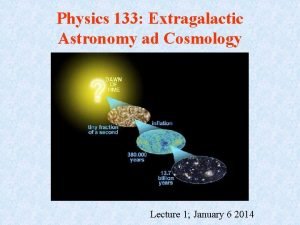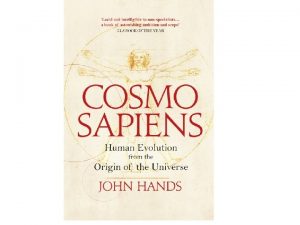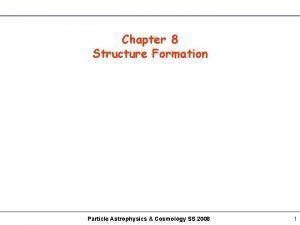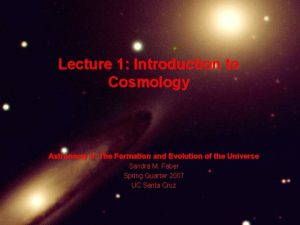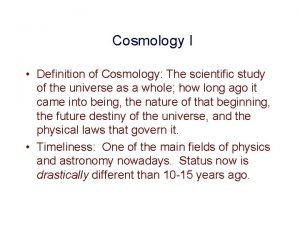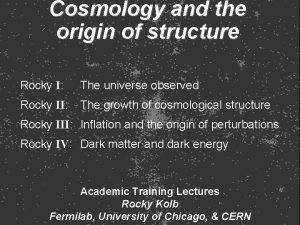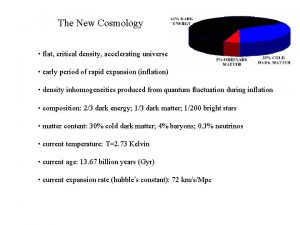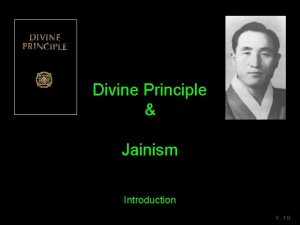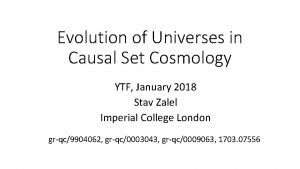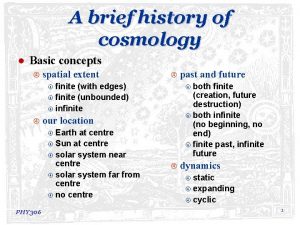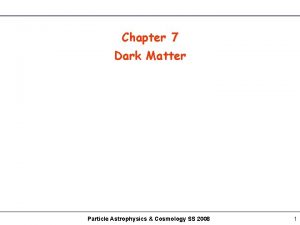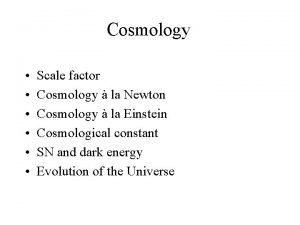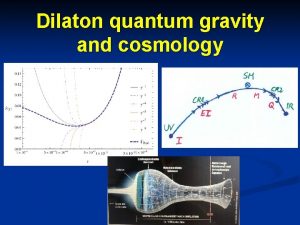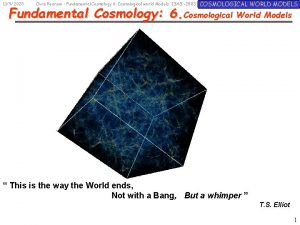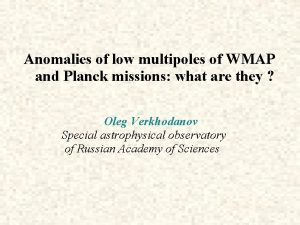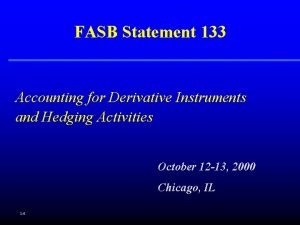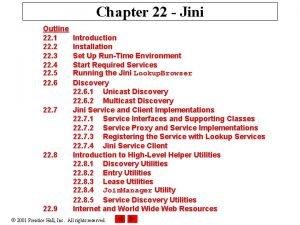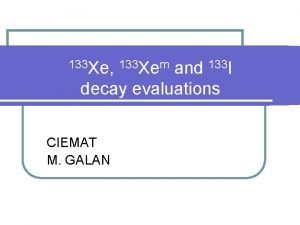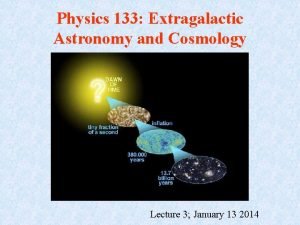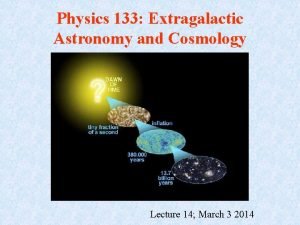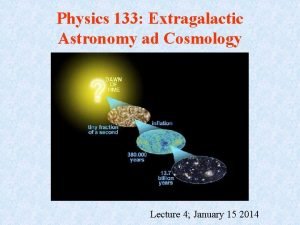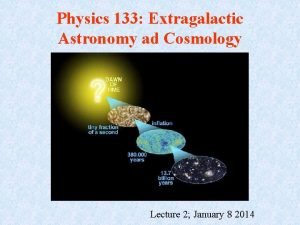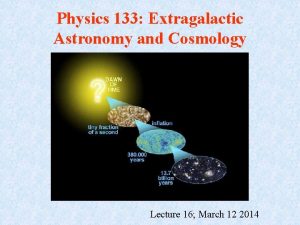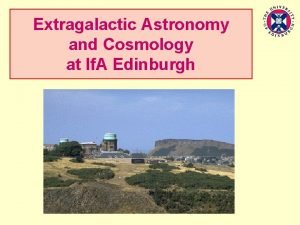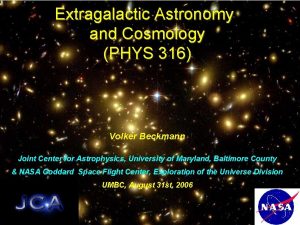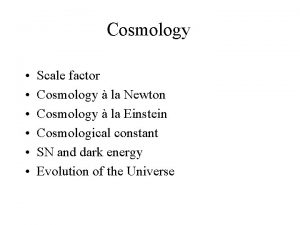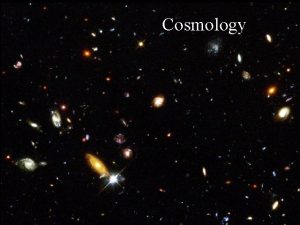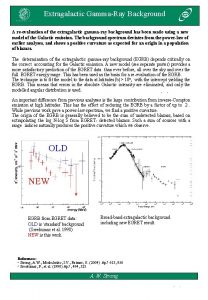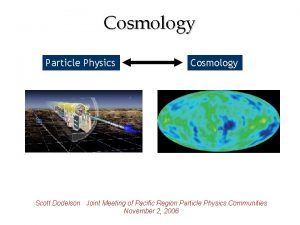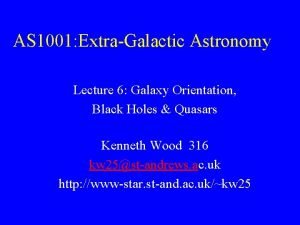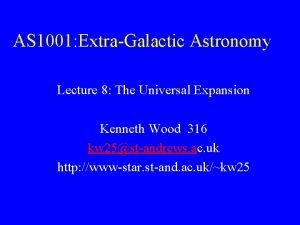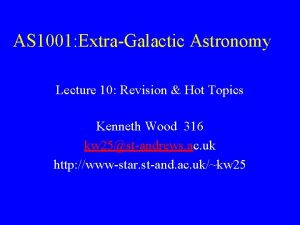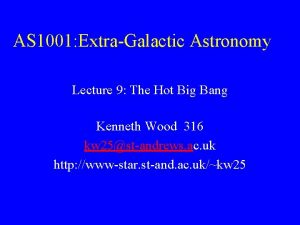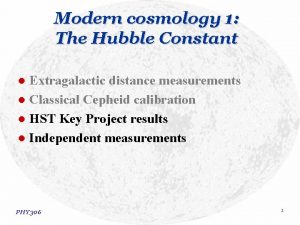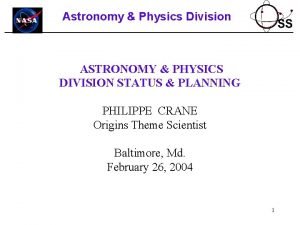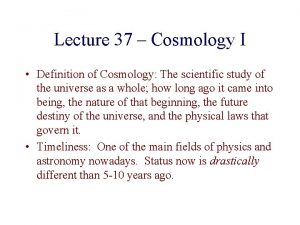Physics 133 Extragalactic Astronomy ad Cosmology Lecture 1





























- Slides: 29

Physics 133: Extragalactic Astronomy ad Cosmology Lecture 1; January 6 2014

Physics 133 • Instructor: Prof. Tommaso Treu – Lectures: MW 9: 30 -10: 45 PHELP 3519 – Office hours: M 2: 30 3: 30 W 11: 00 -12: 00 Broida 2015 F • TA: Mr. Jared Brooks – Office hours: TBD • MIDTERM: – February 5 2014 • FINAL EXAM: March 19 2014 8: 00 -11: 00

Physics 133 • Textbooks: – Introduction to Cosmology, Barbara S. Ryden • Prerequisites: completion of the lower division physics series. • Website: www. physics. ucsb. edu/~tt/PHYS 133 • Power point files, homework, and reading assignments will be found on the website

Physics 133 • Grading: – 20% Homework – 20% Class participation – 20% midterm (Februrary 5 2014) – 40% final exam (March 19 2014 – 8 -11 AM)

Physics 133 • Homework assigned on wednesday is due the next on Wednesday at 4: 00 PM (details from the TA) • Class participation is essential. Ask questions! There are no stupid questions!!! • Grades as in Table. There will be some renormalization to ensure grades are sensible A+ 95% C+ 60% A 90% C 55% A- 85% C- 50% B+ 80% D 40% B 75% F <40% B- 70%

Physics 133

Physics 133: More big questions • Is the Universe evolving? • If so, how and when did it form? – How and when did galaxies and black holes form? • How big/old is the universe? – What’s the geometry of the Universe? Dynamics? • Can we put together a physical model of the universe and its contents, capable of reproducing the observations and predicting falsifiable observations? The best we could come up so far is the so-called Standard Cosmological Model (by analogy with particle physics’ Standard Model)

Physics 133 • Cosmology uses all the knowledge of physics that we learn from laboratory experiments • Some of the most extraordinary discoveries in physics come from cosmology: dark matter and dark energy, just to name two • The subject of the discipline is unique: we only have one Universe, we cannot replicate/alter/reproduce our “sample” • We can only do experiments and measurements from one specific point in time and space

Physics 133: Tools of the trade – Telescopes as time machines

Physics 133: a golden era for cosmology

Physics 133: the role of observations • Experiments and Observations force us to modify/change our view of the Universe. Examples: – Galileo’s observations of sun spots proved that the heavens are not time-invariant – Hubble’s measurement of galaxy redshifts showed that the Universe is not static – High speed motions of stars in galaxies show that either we do not understand gravity or that there is a large amount of “dark matter”, i. e. different stuff that the ones that makes you and me (and Earth)

Physics 133: a fundamental dilemma… • Experiments and Observations can only be made from a very special point in space and time: Earth now. • Yet we would like to construct a scientific theory that describes the universe everywhere and at all times.

Physics 133: … and its solution • Physicists postulate a universal principle: our local sample of the universe is no different from more remote and inaccessible places • This postulate is deeply rooted in two fundamental principles of physics: – The laws of physics (whatever they are!) do not depend on space and time – Physical explanations of natural phenomena should be as simple as possible (Ockham’s razor)

Physics 133: cosmological principles • 1) Cosmological (Copernican) principle: the universe is homogeneous and isotropic

Physics 133: cosmological principles • 2) Perfect cosmological principle: The universe is homogenous, isotropic, and time-invariant Inconsistent with observations!

Physics 133: outline. Part 1 • Observational foundations of the Big Bang theory – – – • Olbers’ paradox Homogeneity and isotropy Hubble’s Law Composition of the Universe Cosmic Microwave Background Geometry and gravity: – A brief introduction to general relativity

Physics 133: outline. Part 2 • Friedman-Lemaitre. Robertson-Walker Universe – Robertson-Walker metric – Cosmic Dynamics – Special cases and observables – Cosmography • • Dark matter Dark energy

Physics 133: outline. Part 3 • The early universe: – Thermodynamics of the early Universe – Matter vs. antimatter – Bing bang nucleosynthesis • Inflation – Problems of classic Big Bang – The inflationary solution

Physics 133: outline. Part 4 • The content of the universe: – The formation of structure – Galaxies – Clusters of galaxies – Supermassive Black holes

Units in astronomy. Length: • Astronomical Unit (AU) = average distance Sun – Earth. ~1. 5 e 11 m. Too small • parsec (pc) -> kiloparsec (kpc), megaparsec Mpc (Mpc), Gigaparsec (Gpc) • 1 pc = Distance at which 1 Astronomical Unit subtends an angle of 1 arcsecond (3. 086 e 16 m) • Examples: • • Distance between stars in the solar neighborhood: pc Size of a galaxy like the Milky Way: kpc Distance between galaxies or size of clusters: Mpc Distance of the most distant objects known: Gpc

Units in astronomy. Mass, Luminosity and Time: • M. Solar mass: 1. 98 e 30 Kg – A large galaxy is typically 1011 -12 solar masses – A cluster is typically 1014 -15 solar masses • L. Solar luminosity: 3. 8 e 26 watt – A large galaxy is typically 1010 -11 solar luminosities (what does this mean in terms of mass to light ratio? ) • T. Period of Earth’s orbit (yr): ~π 107 s – Typically times are measured in Gyrs. The age of the Earth is 4. 6 Gyr, the age of the Universe is 13. 7 Gyr.

Units in astronomy. Units from microscopic physics • E. Energy: e. V = 1. 6 e-19 J – Mass of the electron = 0. 511 Me. V – Mass of the proton = 938 Me. V • L. Angstrom: Å = 10 e-8 m • Planck units (combining fundamental constants): – – l. P=√(G hbar / c 3) = 1. 6 e-35 m MP=√(hbar c /G) = 2. 2 e-8 kg t. P=√(G hbar/c 5) = 5. 4 e-44 s (similary one can define Planck’s energy and Temperature)

Olbers’ paradox. The night sky • • The night sky is dark!! This apparently superficial statement (formulated by Heinrich Olbers in the early 1800 s) has very profound consequences and is one of strongest pieces of evidence in favor of the big bang

Olbers’ paradox. A step back. . • • • Newton’s model of the universe was: Eternal Infinite (otherwise it would collapse gravitationally) Flat Space Time independent of space

Olbers’s paradox. What does the sky look like in Newton’s model? • • For every line of sight sooner or later you find a star Surface brightness is independent of distance for a Euclidean flat space (draw on the blackboard) This would mean that the sky should have the same surface brightness of the sun, your average Joe star, e. g. the Sun. . . [Blackboard]

Olbers’ paradox. Olbers’ solution. • • Olbers postulated that the Universe was filled with an absorbing medium, like fog However, if light is absorbed it would heat up the medium, which would re-radiate, producing light albeit at different wavelengths, so this doesn’t work!

Olbers’ paradox. The Big-Bang’s solution • • In the Big Bang model the Universe is finite in TIME (13. 7 billion years) This means that we can only see as far away as light has had time to travel Furthermore stars were not always shining (the sun for example is 4. 5 Gyrs old). More later. .

Olbers’ paradox. Summary • • • The night sky is dark This implies that the emission of starlight in the universe must be finite, in space, time or both. This is fundamental test for any cosmological model The Big-bang explains Olbers’ paradox with the finiteness of the lifetime of the Universe and hence of its stars: The universe is NOT eternal in the past! The universe evolves!

The End See you on Wednesday!
 Extragalactic astronomy
Extragalactic astronomy Learning astronomy by doing astronomy activity 7 answers
Learning astronomy by doing astronomy activity 7 answers Learning astronomy by doing astronomy activity 1 answers
Learning astronomy by doing astronomy activity 1 answers Learning astronomy by doing astronomy activity 1 answers
Learning astronomy by doing astronomy activity 1 answers Michigan state university astronomy
Michigan state university astronomy Concordance model of cosmology
Concordance model of cosmology Cosmology
Cosmology Intro to cosmology
Intro to cosmology Definition of cosmology
Definition of cosmology Cosmology
Cosmology Critical density cosmology
Critical density cosmology Jain geography
Jain geography Cosmology
Cosmology Newton cosmology
Newton cosmology Cosmology
Cosmology Scale factor cosmology
Scale factor cosmology Crossover cosmology
Crossover cosmology Cosmology
Cosmology Multipole
Multipole 01:640:244 lecture notes - lecture 15: plat, idah, farad
01:640:244 lecture notes - lecture 15: plat, idah, farad Waves pdf download
Waves pdf download Physics 101 lecture notes pdf
Physics 101 lecture notes pdf Atmospheric physics lecture notes
Atmospheric physics lecture notes Physics 101 lecture 1
Physics 101 lecture 1 Physics 101 lecture notes pdf
Physics 101 lecture notes pdf Classical mechanics
Classical mechanics Fasb 133
Fasb 133 Signing naturally 3:9
Signing naturally 3:9 Jini 133
Jini 133 Xe-133 decay
Xe-133 decay
